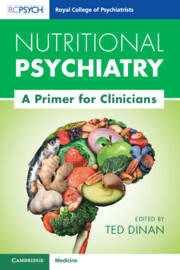Book contents
- Nutritional Psychiatry
- Nutritional Psychiatry
- Copyright page
- Contents
- Contributors
- Preface
- Chapter 1 Basic Principles of Nutrition
- Chapter 2 Diet and the Microbiome–Gut–Brain Axis
- Chapter 3 The Mediterranean Diet and Mental Health
- Chapter 4 Psychobiotics and Fermented Foods
- Chapter 5 Diet Interventions for Anxiety and Depression
- Chapter 6 Schizophrenia, Microbiota and Nutrition
- Chapter 7 Recognising the Importance of Nutrition for Child and Adolescent Mental Health
- Chapter 8 Old Age and Nutrition
- Chapter 9 Broad-Spectrum Micronutrients and Mental Health
- Chapter 10 Epigenetics
- Index
- References
Chapter 1 - Basic Principles of Nutrition
Published online by Cambridge University Press: 17 August 2023
- Nutritional Psychiatry
- Nutritional Psychiatry
- Copyright page
- Contents
- Contributors
- Preface
- Chapter 1 Basic Principles of Nutrition
- Chapter 2 Diet and the Microbiome–Gut–Brain Axis
- Chapter 3 The Mediterranean Diet and Mental Health
- Chapter 4 Psychobiotics and Fermented Foods
- Chapter 5 Diet Interventions for Anxiety and Depression
- Chapter 6 Schizophrenia, Microbiota and Nutrition
- Chapter 7 Recognising the Importance of Nutrition for Child and Adolescent Mental Health
- Chapter 8 Old Age and Nutrition
- Chapter 9 Broad-Spectrum Micronutrients and Mental Health
- Chapter 10 Epigenetics
- Index
- References
Summary
The basic principle of nutrition is the provision of adequate nutrients for populations or groups within populations. Adequate nutrition requires that all nutrients are consumed in adequate amounts and in the correct proportions. Energy is one of the most important things we obtain from food. In the body, energy consumed is used to support metabolic processes. Energy expenditure is made up of three components: basal metabolic rate, thermic effect of food and physical activity. Within the diet, the role of carbohydrates is to be a source of fuel, but overall carbohydrates are also part of energy stores, structural components of cell walls, part of nucleic acids (RNA and DNA) and part of many proteins and lipids. Protein is the most abundant nitrogen-containing compound in the diet. It is a major functional and structural component of all body cells. Fats, also known as lipids, are composed of a carbon skeleton with hydrogen and oxygen substitutions. Understanding the pathway for each nutrient allows for the development of dietary reference values, which aim for optimal levels of a nutrient for each population group. The types of foods eaten in different countries are influenced by factors such as ethnicity, culture, dietary habits, food preferences, intake patterns and food availability, and so the classification and types of foods contained in the major ‘food groups’ can vary somewhat from country to country.
- Type
- Chapter
- Information
- Nutritional PsychiatryA Primer for Clinicians, pp. 1 - 14Publisher: Cambridge University PressPrint publication year: 2023



